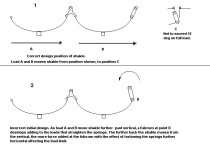andyfletcher
Bronze Member
- Joined
- Mar 16, 2004
- Messages
- 66
The drawing included shows the way I design my shakle
position both for single and double axle (Example 1). The shakle for a double differs in that more degree tilt to the right is required at frame attach point to compensate for the added total horizontal spring length. Point C should not go beyond 15 deg in my view, and that's a ballpark figure, otherwise the fulcrum effect would occur.
A shakle tilted to the left of vertical in design and welded to frame as shown Example 2 creates an added force decreasing load limit as the loaded trailer works the spring in compression (horizontal from semi-circular). The added force comes from the spring itself by creating a fulcrum point on the shakle at the spring/shackle eyelet D.
What do you think?
Fletch
position both for single and double axle (Example 1). The shakle for a double differs in that more degree tilt to the right is required at frame attach point to compensate for the added total horizontal spring length. Point C should not go beyond 15 deg in my view, and that's a ballpark figure, otherwise the fulcrum effect would occur.
A shakle tilted to the left of vertical in design and welded to frame as shown Example 2 creates an added force decreasing load limit as the loaded trailer works the spring in compression (horizontal from semi-circular). The added force comes from the spring itself by creating a fulcrum point on the shakle at the spring/shackle eyelet D.
What do you think?
Fletch
